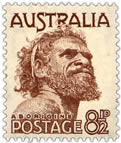History
Timeline results for
Found 1175 results for your search. Showing page 12 of 59.
1949
-
A group of Aboriginal stockmen including Ampilatwatja man Banjo Morton walk off from the Lake Nash Cattle Station demanding wages instead of rations. After a short period they are paid one pound a week. It is the first time Aboriginal stockmen walked off disputing labour conditions in the NT.
1950
-
The first formal schooling for Aboriginal children in the Northern Territory is provided. Lack of facilities is rationalised by the claim that children “beyond the age of 10 couldn’t keep up with white children anyway”.
-
Aboriginal children assimilate into NSW local schools, if all other parents agree. This right of veto is removed in 1960.
-

Gwoya Jungarai The portrait of Gwoya Jungarai (c.1895-1965, also spelled Tjungurrayi or Djungarai) of the Warlpiri people, Central Australia, appears on the 8 1/2 pence (8 1/2d) and two shillings and sixpence (2s.6d, issued 1952) definitive stamps. It is the first time a living Australian — settler or Aboriginal — is featured on a stamp.
The stamps become widely known as “One Pound Jimmy” because when asked the price of his artefacts for sale Gwoya always replied “One Pound”. Tjungurrayi was a stockman, traditional lawman, and survivor of the brutal 1928 Coniston massacre. His portrait is later engraved on the two dollar coin.
1951
-
The federal government convenes the Australian Conference for Native Welfare, with all states and territories represented except Victoria and Tasmania, which claim to have no Aboriginal ‘problem’. The conference officially adopts a policy of ‘assimilation’ for Aboriginal people.
"Assimilation means, in practical terms, that it is expected that all persons of Aboriginal birth or mixed blood in Australia will live like white Australians do." [1]
1952
-
In a progressive decision, the Minister for Territories, Paul Hasluck, earmarks all statutory royalties raised on Aboriginal reserves to be held in trust for Aboriginal people. All royalties raised on Aboriginal land are foregone by the Commonwealth and paid to a new institution, the Aboriginals Benefit Trust Account (ABTA).
1953
-
A new series of Australian banknotes issued in 1953-1954 is the first to refer directly to First Nations culture. The back of the £5 banknote shows two shields and a boomerang among elements that represent a harvest (wheat, barley, fruits, ram, ewe, bull and a cow). [2]
-
The Northern Territory Welfare Ordinance makes Aboriginal people wards of the government, basically making Aboriginal adults and children, minors.
-
Atomic tests are conducted on Maralinga lands at Emu Field, South Australia. They are code named Operation Totem. A black cloud passes and hundreds of families are forced to leave their homelands because of severe contamination. Further atom tests followed in 1956 at Maralinga, South Australia - Operation Buffalo.
10 years after the Australian government declared the clean-up of Maralinga as completed (in 2001) erosion continues to expose radioactive waste repositories.The remarkable thing really, is how little [radioactive material] we buried.
— Alan Parkinson, retired nuclear engineer [3]
1954
-
Queen Elizabeth visits Australia for the first time and in Canberra signs the Aborigines Welfare Ordinance 1954 that permits the ethnic cleansing of the Australian Capital Territory, clearing it of resident Aboriginal people.
1955
-
Melbourne stages its first Moomba festival. Approached about naming the festival, Aboriginal people suggest “Moomba”, telling the officials it means “Let’s get together and have fun!” Actually meaning “up your bum” the name was adopted and is still used.
1957
-
Atomic testing (Operation Antler) at Maralinga, South Australia. The presence of Aboriginal people on the test site is documented.
-
Formation of the NADOC - National Aboriginal Day Observance Committee (later: NAIDOC, with the ‘I’ for ‘Islanders’).
-
Victorian Aborigines Welfare Board replaces the Board for the Protection of Aborigines. The Welfare Board is abolished in 1967.
-
In the Northern Territory the powers of the Chief Protector over Aboriginal children are repealed.
-
The Palm Island workforce demonstrates and strikes against unfair wages and apartheid. In response, the Queensland government dispatches 20 police to put the rebellion down. At gunpoint, 7 men and their families are shipped off the island in leg irons and transported to settlements on the mainland.
1958
-
Federal Council for the Advancement of Aborigines is set up. It group brings together a number of civil rights and Aboriginal welfare organisations. Its work plays a large part in bringing about the 1967 referendum. In 1964 the title changes to Federal Council for the Advancement of Aborigines and Torres Strait Islanders (FCAATSI).
1959
-
Margaret Williams is the first Aboriginal university graduate with a diploma in physical education. [4]
1960
-
Despite their enormous talents, an Aboriginal player wasn't selected in the Australian team until 1960. His name is Lionel Morgan. Morgan plays two tests against the French and later that year in the World Cup squad. He also plays with Aboriginal player (and eventual Test cap) George Ambrum at Wynnum Manly.
-
The Western Australian Department of Native Affairs ceases forcefully taking Aboriginal children from their parents and sending them to missions.
References
View article sources (4)
[1]
'Timeline of legislation affecting Aboriginal people', DECS Curriculum Services, www.aboriginaleducation.sa.edu.au
[2]
'First Nations Peoples and Australian Banknotes - Colony', Reserve Bank of Australia Museum, available at museum.rba.gov.au/exhibitions/first-nations-peoples-and-australian-banknotes/colony/
[3]
'Ten years after the all-clear, Maralinga is still toxic', SMH 12/11/2011
[4]
'Doctor Dylan achieves for his people', Daily Telegraph 9/4/2012
